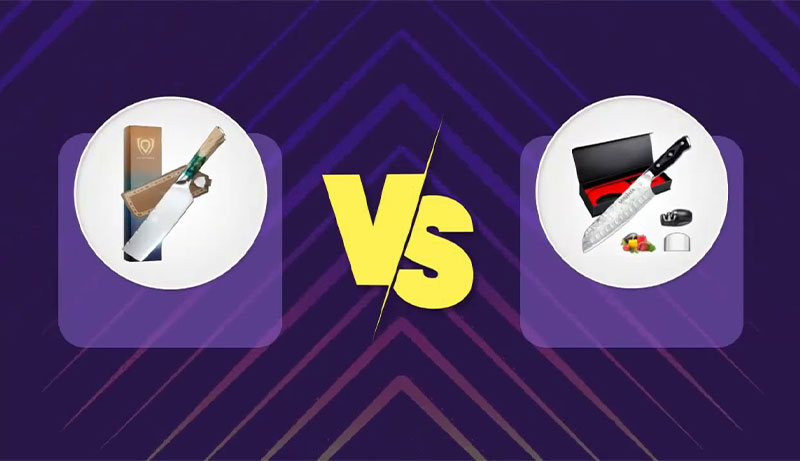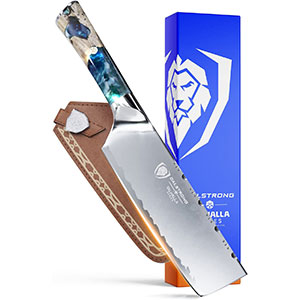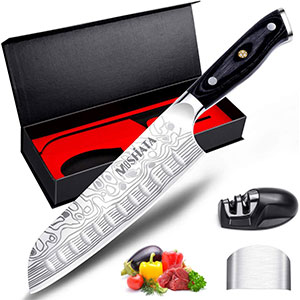As an affiliate, we may earn a commission from qualifying purchases. We get commissions for purchases made through links on this website from Amazon and other third parties.
Santoku and Nakiri are two shapes that frequently lead to confusion in the field of Japanese chef knives. These two knives have vastly diverse functions despite the fact that they initially appear to be similar.
The Santoku is the most popular all-purpose knife and is ideal for slicing, dicing, and mincing. The Nakiri, on the other hand, is made exclusively for cutting vegetables. The choice between a santoku and a Nakiri knife ultimately boils down to personal preference. We’ll examine the distinctions between Santoku and Nakiri knives so you can choose which is right for you.
What is a Nakiri Knife?
A Japanese vegetable knife is called a nakiri. It has a blade that is rectangular and made especially for chopping vegetables. The Japanese word “Nakiri” means “vegetable cutter.”
A Nakiri knife, in contrast to a chef’s knife, is made to be used for chopping vegetables in an up-and-down or back-and-forth motion. Chef’s knives have curved blades that are perfect for dicing. As a result, it is frequently employed for jobs like chopping cabbage, dicing onions, and mincing garlic. The Nakiri knife is renowned for both its use in the kitchen and its understated elegance. A Nakiri knife may be a fantastic addition to your kitchen, whether you’re an experienced chef or just getting started.
What is a Santoku Knife?
A Santoku knife is an all-purpose culinary tool from Japan. The term “Santoku” is Japanese for “three virtues” or “three uses,” which alludes to the three cutting operations it is best at: mincing, dicing, and slicing.
The Santoku knife, which combines Nakiri and Gyuto, is excellent for chopping vegetables and meat. Compared to a chef’s knife made in the West, it has a shorter blade and is typically lighter and easier to hold.
Although it is frequently used in Japanese cuisine, it has only recently gained popularity as people learned about its many advantages. So if you’re searching for a functional and versatile kitchen knife, a Santoku might be the best choice.
What are the Differences Between Nakiri Vs Santoku Knife?
After looking at Santoku and Nakiri knives, let’s contrast and compare these two well-liked knife types.
The blade
Typically, the Santoku’s blade length is between 12 and 18 cm, making it shorter than a chef’s knife. The blade’s tip curve is usually less prominent and it is frequently thinner. The Santoku is hence excellent for push cuts and fine slicing.
The Nakiri has a generally 15–18 cm long, rectangular profile. The knife’s edge is razor-sharp and gun-barrel straight, making it perfect for slicing through veggies.
Utility
A well-known and versatile knife, the Santoku can be used for many different tasks, including chopping vegetables, slicing meat, and mincing herbs.
The ideal option for vegetarians and vegans is the Nakiri, a specialized knife with a flat blade edge and square tip made especially for chopping vegetables. Although it resembles a cleaver in profile, it cannot be used for other tasks like slicing meat or breaking bones.
The knife’s weight
Santoku knives normally have a blade that weighs between 155 and 227 grams, whereas Nakiris typically weigh between 4 and 6 ounces per handle length (although this can vary depending on the maker).
This implies that because of their lighter structure, which also helps them feel more comfortable in your hand, they are simpler to chop and slice vegetables and fruit.
Corner Grind
Check out Nakiri knives if you’re seeking for a blade that can handle cutting with precision. Due to their double beveling, nakari knives are able to make precise cuts and keep their edge well. Santokus are comparable, but some contemporary varieties have thicker blades that are better suited to western-style cooking. Pay particular attention to the blade thickness when choosing Santoku.
Cutting Motion
Nakiri cuts and chops fruits and vegetables with a forceful cutting motion. Santoku knives, on the other hand, slice meat, fish, and vegetables neatly with a rocking, straight up and down cutting motion.
Price of knives
Because they are made of better materials than Santoku knives, Nakiri knives are typically more expensive. Santoku knives, on the other hand, are less expensive and still provide excellent value.
Handle design
While the Nakiri more frequently have a Japanese-style handle, modern Santoku typically have a Western-style handle (although traditionally it would be the “Wa” handle).
Kind of tip
The Nakiri has a square tip, while the Santoku has a pointy tip.
the material with which the knife was crafted
While the Nakiri is typically made of high-quality carbon steel or Damascus steel, the Santoku is typically made of carbon steel or stainless steel.
Finishing
While the Nakiri can be etched with traditional Japanese symbols or decorated with intricate patterns, the Santoku typically has a polished finish.
Conclusion
You find yourself at a fork in the road where two pathways split apart in a dark jungle. There are two signs: one side says “Santoku,” the other says “Nakiri.” But which way should I go?
Choose a Santoku if you’re just getting started in the kitchen and only need one knife. In a variety of circumstances, it will be a good fit for your needs. But if you love vegetables, go with a Nakiri; you won’t be dissatisfied. Whatever route you take, we hope you enjoy cooking!




